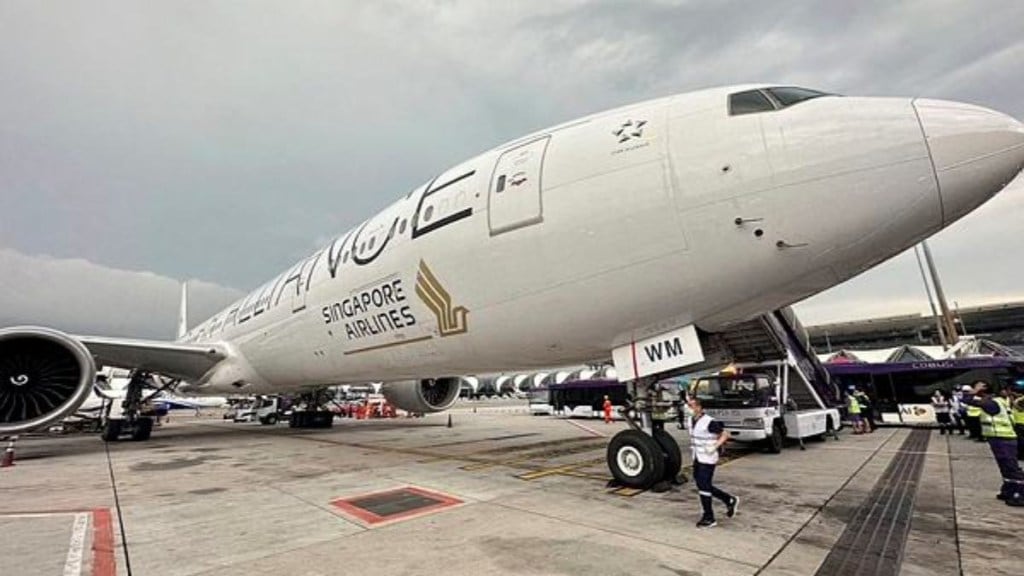One passenger died of a suspected heart attack, and several others were injured after a Singapore Airlines flight from London to Singapore hit severe turbulence on Tuesday (May 21), forcing the Boeing 777-300ER to divert to Bangkok, authorities said.
Flight SQ321, which departed from London’s Heathrow Airport, encountered severe turbulence about 10 hours into its journey over the Irrawaddy Basin in Myanmar. The turbulence hit as the cabin crew was serving breakfast, causing the plane to rapidly descend into an air pocket. This led to an emergency landing request at Bangkok’s Suvarnabhumi International Airport, where the flight landed at 3:45 pm local time on Tuesday.
What is turbulence?
Turbulence, caused by disturbed air pockets, can result from unstable weather patterns that trigger storms, according to Airbus. These water particles can be detected by weather radar. Singapore Airlines has not specified the type of turbulence involved, but FlightRadar24 noted some severe storms in the area at the time.
Clear air turbulence (CAT) is a sudden, severe swirl that causes violent plane buffeting without any visible clouds, according to the Federal Aviation Administration. These invisible air pockets can appear without warning and are hard to predict.
A Reuters report quoted Mark Prosser from the University of Reading explaining that Tuesday’s event likely involved storm-related turbulence but emphasised it was too early to be certain. An investigation has been launched, as aircraft accidents typically involve multiple factors.
How common is turbulence and CAT?
Turbulence-related incidents are common. A 2021 study by the US National Transportation Safety Board found that from 2009 through 2018, turbulence accounted for more than a third of reported events, most resulting in serious injuries but no aircraft damage. Fatal turbulence is extremely rare. Paul Hayes of Cirium Ascend noted that it has been over 25 years since a passenger died due to turbulence, with the last fatal incident involving a United Airlines Boeing 747 in 1997.
How do pilots respond to turbulence?
Pilots plan by studying weather forecasts, loading extra fuel if needed, and monitoring weather radar during flight. However, violent CAT can leave little time to react. Retired pilot Hugh Dibley noted that unexpected turbulence requires warnings from other aircraft and slowing down to minimise effects. “If it’s unexpected then it’s a bit late. You hope to get warnings from other aircraft in the area and slow down to make sure the effects are minimised,” said retired pilot.
Which planes handle turbulence best?
All modern commercial jets are structurally designed to withstand forces much greater than those encountered during flight, according to Hayes. However, the experience of turbulence can vary for passengers depending on the aircraft and seat location. Long planes tend to feel most turbulent at the back, while the ideal spot is around the center of gravity, typically just ahead of the wings.
Boeing’s 787-9, featuring Honeywell’s “Gust Alleviation System,” is rated highest for handling turbulence by the Swedish turbulence-forecasting website Turbli. The next best is the Airbus A340-500/600, although this four-engined model is less common due to fuel costs.
The Boeing 777 family has a strong safety record, despite the 2014 incidents involving Malaysia Airlines MH17 and MH370. While it is equipped with traditional weather radar, it lacks the advanced alleviation system found in the newer 787.
Do seat belts help during turbulence?
US airline pilot and flight attendant unions emphasise the importance of wearing seatbelts whenever seated. However, keeping the seatbelt sign on all the time may diminish its significance. Crew members, who must check that passengers have fastened their seatbelts, are particularly vulnerable to injury.
New technology to detect turbulence coming up?
NASA is developing an early-warning system using ground-mounted infrasonic microphones to detect CAT hundreds of miles away. Austria-based Turbulence Solutions is working on technology to eliminate up to 80% of turbulence. However, new aircraft systems require years of rigorous testing and validation, with airlines typically bearing the upgrade costs.
(With inputs from Reuters)

